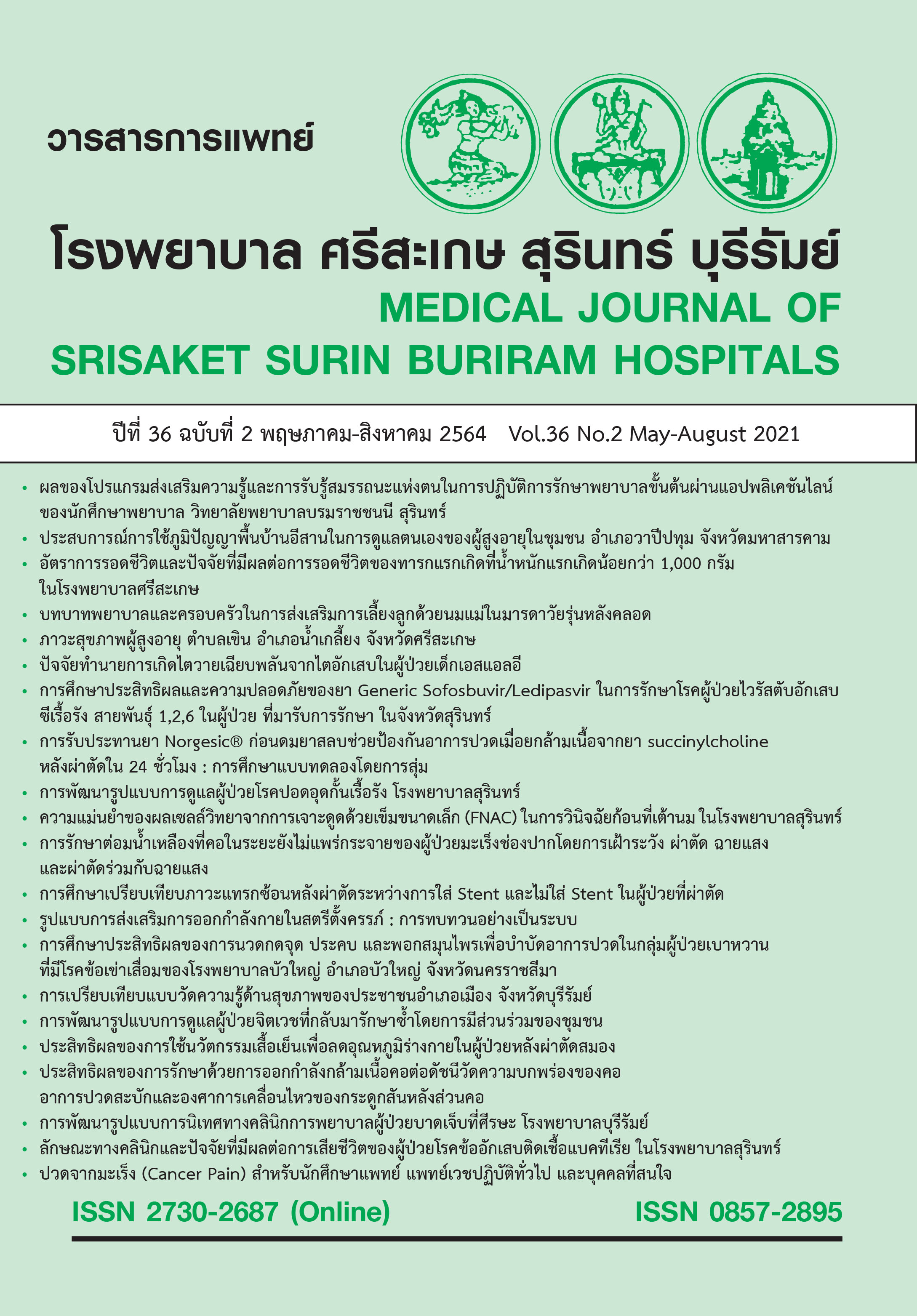ความแม่นยำของผลเซลล์วิทยาจากการเจาะดูดด้วยเข็มขนาดเล็ก (FNAC) ในการวินิจฉัยก้อนที่เต้านม ในโรงพยาบาลสุรินทร์
Main Article Content
บทคัดย่อ
หลักการและเหตุผล: การวินิจฉัยทางเซลล์วิทยาจากการเจาะดูดด้วยเข็มขนาดเล็ก (FNAC) เป็นส่วนหนึ่งในการประเมินผู้ป่วยมีก้อนที่เต้านม 3 ด้าน (Triple Assessment) ประกอบด้วยการตรวจร่างกายรวมถึงการซักประวัติ ร่วมกับการประเมินทางรังสีวินิจฉัย (Mammogram และ Ultrasound) และการวินิจฉัยทางพยาธิวิทยา (Fine needle aspiration cytology: FNAC หรือ Core needle biopsy: CNB) มีบทบาทสำคัญสำหรับใช้เป็นแนวทางในการตัดสินใจและการจัดการก่อนการผ่าตัด มีประโยชน์เนื่องจากรายงานผลวินิจฉัยได้เร็ว มีความแม่นยำ ประหยัดต้นทุนและไม่ทำให้ผู้ป่วยเจ็บตัวมาก
วัตถุประสงค์: เพื่อศึกษาความถูกต้องของ FNAC เมื่อเทียบกับผลชิ้นเนื้อและศึกษาปัจจัยที่มีผลต่อการวินิจฉัยกรณีไม่สอดคล้องระหว่างผล FNAC และผลชิ้นเนื้อ
วิธีการศึกษา: การศึกษานี้เป็นการศึกษาแบบตัดขวาง โดยการรวบรวมข้อมูลผู้ป่วยที่มีก้อนเต้านมและได้รับการวินิจฉัยทางเซลล์วิทยาด้วยเข็มเจาะดูดขนาดเล็ก (FNAC) ตามด้วยการตรวจชิ้นเนื้อจากรอยโรคเดียวกันในโรงพยาบาลสุรินทร์ ตั้งแต่ 1 มกราคม 2555 ถึง 31 ธันวาคม 2563 มีการรายงานผล FNAC อ้างอิงจาก The International Academy of Cytology Yokohama System for Reporting Breast Fine-Needle Aspiration Biopsy Cytopathology จำนวนสิ่งส่งตรวจทางเซลล์วิทยามี 485 เคสคัดเลือกกลุ่มรายงานผลเซลล์วิทยาเป็น Unsatisfactory ออกจากการศึกษา ได้จำนวนเคสที่เข้าทำการศึกษาทั้งสิ้น 373 เคส จากจำนวนผู้ป่วย 342 ราย โดยจัดกลุ่ม C2 และ C3 อยู่ในกลุ่มไม่ใช่มะเร็ง จัดกลุ่ม C4 และ C5 อยู่ในกลุ่มมะเร็ง เพื่อคำนวณหาค่าความแม่นยำ ข้อมูลเชิงปริมาณวิเคราะห์โดยใช้ซอฟต์แวร์การวิเคราะห์ทางสถิติ (STATA) และ วิเคราะห์ข้อมูลด้วยวิธี Generalized Estimating Equations (GEE) ข้อมูลได้รับการประเมินอัตราส่วนความน่าจะเป็น (likelihood ratio) คำนวณความแม่นยำ (accuracy) ความไว (sensitivity) ความจำเพาะ (specificity) ค่าทำนายเชิงบวก (positive predictive value) ค่าทำนายเชิงลบ (negative predictive value) ผลบวกเท็จ (false positive) และผลลบเท็จ (false negative) และมีการอธิบายความสัมพันธ์ของปัจจัยที่มีผลต่อการวินิจฉัยที่ไม่ลงรอยกัน (discordant) ระหว่างผล FNAC และผลชิ้นเนื้อ
ผลการศึกษา: การศึกษาสิ่งส่งตรวจทั้งหมดจำนวน 373 เคส พบรอยโรค benign (C2) 274 เคส (ร้อยละ 73.5); รอยโรค atypical (C3) 5 เคส (ร้อยละ 1.3); รอยโรคสงสัยมะเร็ง (C4) 20 เคส (ร้อยละ 5.4) และรอยโรคที่เป็นมะเร็ง (C5) 74 เคส (ร้อยละ 19.8) ผลการศึกษาการตรวจวินิจฉัยก้อนบริเวณเต้านมโดย Fine Needle Aspiration Cytology(FNAC) เมื่อเทียบกับผลชิ้นเนื้อ พบว่ามีค่าความไว(sensitivity), ความจำเพาะ (specificity), โอกาสที่ผู้ป่วยมีผลชิ้นเนื้อเป็นมะเร็งหากรายงานผล FNAC เป็นมะเร็ง (positive predictive value), โอกาสที่ผู้ป่วยมีผลชิ้นเนื้อไม่เป็นมะเร็งหากรายงานผล FNAC ระบุว่าไม่เป็นมะเร็ง (negative predictive value) และมีความแม่นยำ (accuracy) คิดเป็นร้อยละ 90.3, 99.6, 98.9, 96.4 และ 97.1 ตามลำดับ มีผลบวกลวง (false positive) คิดเป็นร้อยละ 0.3 ผลลบลวง (false negative) คิดเป็นร้อยละ 2.7 เมื่อได้รับการวินิจฉัย FNAC ไม่เป็นมะเร็ง(benign) อัตราการต่อรองที่ผู้ป่วยจะเป็นมะเร็ง (likelihood ratio) ลดลงจาก baseline risk 0.10 เท่า ในช่วงความเชื่อมั่น 0.06-0.18 เมื่อได้รับการวินิจฉัยสงสัยเป็นมะเร็ง (suspicious, favor malignancy) อัตราการต่อรองที่ผู้ป่วยจะเป็นมะเร็ง (likelihood ratio) เพิ่มขึ้นจาก baseline risk 49.81 เท่า ในช่วงความเชื่อมั่น 6.75 ถึง 367.31 แต่อัตราการต่อรองที่ผู้ป่วยจะเป็นมะเร็ง (likelihood ratio) เมื่อได้รับการวินิจฉัยเป็น atypical (C3)และ malignant (C5) มีค่าเป็นศูนย์และประเมินค่าไม่ได้ตามลำดับ การศึกษานี้พบกรณีวินิจฉัยไม่สอดคล้องกันระหว่างผล FNAC และผลชิ้นเนื้อ 11 เคส เกิดขึ้นในผู้ป่วยที่มีอายุมากกว่าอย่างมีนัยสำคัญ (52.8 ±13.8 ปี เทียบกับ 38.7±15 ปี, OR=1.06, 95% CI (1.03-1.11), p<0.001) ลักษณะก้อนที่มีถุงน้ำร่วมมีแนวโน้มที่จะทำให้มีการวินิจฉัยไม่สอดคล้องกันเมื่อเทียบกับก้อนแข็ง (OR=4.76, 95% CI(1.31-17.25), p=0.018) การวินิจฉัยไม่สอดคล้องกันยังพบได้ในกรณีมีปัญหาคุณภาพสไลด์ ทั้งกรณีขีดจำกัดของปริมาณเซลล์ รวมถึงการเสียสภาพของเซลล์และการปนเปื้อน (OR=10.09, 95% CI(2.61-39.00), p<0.001) และ OR=22.42, 95% CI (3.50-143.57), p<0.001)
สรุป: FNAC มีความแม่นยำสำหรับการวินิจฉัยก้อนที่เต้านม แต่ยังพบข้อจำกัดจากการวินิจฉัยในรอยโรคบางลักษณะที่มีส่วนประกอบเป็นถุงน้ำ (cyst) ปัญหาทางเทคนิค (ขีดจำกัดปริมาณเซลล์และการเตรียมสไลด์) และสิ่งส่งตรวจที่เก็บมาจากผู้ป่วยสูงอายุ ดังนั้นควรพิจารณาร่วมกับการประเมินผู้ป่วย 3 ด้าน (Triple Assessment) เสมอเพื่อเพิ่มความแม่นยำในการวินิจฉัย
คำสำคัญ: เซลล์วิทยาจากการเจาะดูดด้วยเข็มขนาดเล็ก การประเมินผู้ป่วย 3 ด้าน ความแม่นยำ ความไม่สอดคล้องกัน
Article Details
เอกสารอ้างอิง
Sung H, Ferlay J, Siegel RL, Laversanne M, Soerjomataram I, Jemal A, Bray F. Global Cancer Statistics 2020: GLOBOCAN Estimates of Incidence and Mortality Worldwide for 36 Cancers in 185 Countries. CA Cancer J Clin 2021;71(3):209-49. doi: 10.3322/caac.21660.
World Health Organization. Thailand - Global Cancer Observatory. [internet]. 2020. [Cited 2020 Feb 15]. Available from:URL:https://gco.iarc.fr/today/data/factsheets/populations/764-thailand-fact-sheets.pdf
Barton MB, Elmore JG, Fletcher SW. Breast symptoms among women enrolled in a health maintenance organization: frequency, evaluation, and outcome. Ann Intern Med 1999;130(8):651-7. doi: 10.7326/0003-4819-130-8-199904200-00005.
Lester SC. The breast. In: Kumar V, Abbas AK, Fausto N, eds. Robbins and Cotran pathologic basis of disease . Philadelphia : Elsevier Saunders; 2005.
Association of Breast Surgery at Baso 2009. Surgical guidelines for the management of breast cancer. Eur J Surg Oncol 2009;35(Suppl 1):1-22. doi: 10.1016/j.ejso.2009.01.008.
Wang M, He X, Chang Y, Sun G, Thabane L. A sensitivity and specificity comparison of fine needle aspiration cytology and core needle biopsy in evaluation of suspicious breast lesions: A systematic review and meta-analysis. Breast 2017;31:157-66. doi: 10.1016/j.breast.2016.11.009.
Cangiarella J, Simsir A, Tabbara SO. Breast cytohistology. Boston : Cambridge University Press; 2013.
. Lieske B, Ravichandran D, Wright D. Role of fine-needle aspiration cytology and core biopsy in the preoperative diagnosis of screen-detected breast carcinoma. Br J Cancer 2006;95(1):62-6. doi: 10.1038/sj.bjc.6603211.
Shyyan R, Masood S, Badwe RA, Errico KM, Liberman L, Ozmen V, et al. Breast cancer in limited-resource countries: diagnosis and pathology. Breast J 2006;12 Suppl 1:S27-37. doi: 10.1111/j.1075-122X.2006.00201.x.
Field AS, Raymond WA, Rickard M, Arnold L, Brachtel EF, Chaiwun B, et al. The International Academy of Cytology Yokohama System for Reporting Breast Fine-Needle Aspiration Biopsy Cytopathology. Acta Cytol 2019;63(4):257-73. doi: 10.1159/000499509.
No authors listed Guidelines for cytology procedures and reporting on fine needle aspirates of the breast. Cytology Subgroup of the National Coordinating Committee for Breast Cancer Screening Pathology. Cytopathology 1994;5(5):316-34. PMID: 7819517
Chaiwun B, Thorner P. Fine needle aspiration for evaluation of breast masses. Curr Opin Obstet Gynecol 2007;19(1):48-55. doi: 10.1097/GCO.0b013e328011f9ae.
Giard RW, Hermans J. The value of aspiration cytologic examination of the breast. A statistical review of the medical literature. Cancer 1992;69(8):2104-10 doi: 10.1002/1097-0142(19920415)69:8<2104::aid-cncr2820690816>3.0.co;2-o.
Yu YH, Wei W, Liu JL. Diagnostic value of fine-needle aspiration biopsy for breast mass: a systematic review and meta-analysis. BMC Cancer 2012;12:41. doi: 10.1186/1471-2407-12-41.
Lee HC, Ooi PJ, Poh WT, Wong CY. Impact of inadequate fine-needle aspiration cytology on outcome of patients with palpable breast lesions. Aust N Z J Surg 2000;70(9):656-9. doi: 10.1046/j.1440-1622.2000.01920.x.
Mansoor I, Jamal AA. Role of fine needle aspiration in diagnosing breast lesions. Saudi Med J 2002;23(8):915-20. PMID: 12235462
Park IA, Ham EK. Fine needle aspiration cytology of palpable breast lesions. Histologic subtype in false negative cases. Acta Cytol 1997;41(4):1131-8. doi: 10.1159/000332799.
Arisio R, Cuccorese C, Accinelli G, Mano MP, Bordon R, Fessia L. Role of fine-needle aspiration biopsy in breast lesions: analysis of a series of 4,110 cases. Diagn Cytopathol 1998;18(6):462-7. doi: 10.1002/(sici)1097-0339(199806)18:6<462::aid-dc16>3.0.co;2-f.
Mendoza P, Lacambra M, Tan PH, Tse GM. Fine needle aspiration cytology of the breast: the nonmalignant categories. Patholog Res Int 2011;2011:547580. doi: 10.4061/2011/547580.
Ishikawa T, Hamaguchi Y, Tanabe M, Momiyama N, Chishima T, Nakatani Y, et al. False-positive and false-negative cases of fine-needle aspiration cytology for palpable breast lesions. Breast Cancer 2007;14(4):388-92. doi: 10.2325/jbcs.14.388.
Shabb NS, Boulos FI, Abdul-Karim FW. Indeterminate and erroneous fine-needle aspirates of breast with focus on the 'true gray zone': a review. Acta Cytol 2013;57(4):316-31. doi: 10.1159/000351159.


